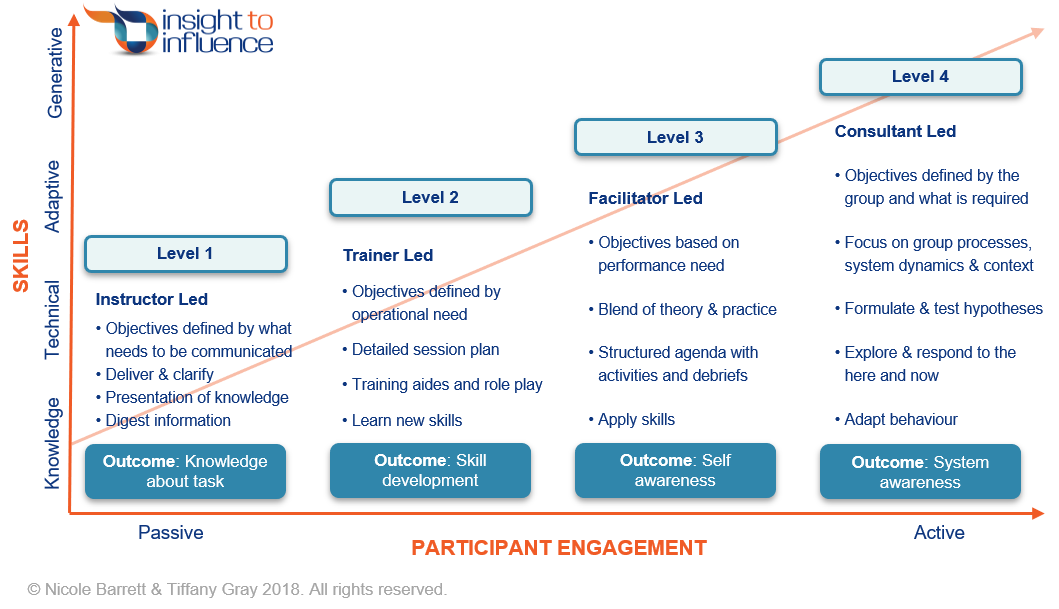Training and Learning: why it's important to know the difference
By Nicole Barrett, Psychologist
Jul 16, 2018

At a recent AICD luncheon, I was speaking with a group of people about what we do at Insight to Influence. One individual chimed in and said, "so, you are a training organisation"? My immediate response was unusually defensive, and a tad semantic, yet I felt compelled to differentiate that we are in the business of 'learning' not training.
It later struck me how the distinction between training and learning is incredibly important. Organisations invest buckets of money based on an expectation that training will enable their people to do something new or differently - yet only learning can achieve this.
The dilemma is: training works and learning works, but which is needed to get the right outcomes? By definition, training gives information or knowledge in a manner that instructs the trainee whereas learning is the re-creation of self in terms of our capacity to apply new knowledge, skills and behaviours in a variety of contexts.
It is important to recognise that training and learning satisfy different business needs and that there are various types of training determined by the learning objectives and participant outcomes that the organisation requires. This then dictates the facilitators role, focus, methods and how actively engaged the participants need to be. However, I can't help wonder...
"Are organisations overly dependent on one-off training events to equip their people with the necessary skills to perform their role?"
When thinking about what is going to meet your organisational need, it is vital to check your expectations, manage any assumptions and get crystal clear on the purpose and desired outcomes so that the learning methods are suitably matched. For example, the following outlines some key distinctions and variation that exists in the field of training.

Not distinguishing between the various levels of participant engagement and required skill level is a huge risk that organisations unconsciously take, often setting themselves up for failure. For example, when undertaking evaluations on the effectiveness of training as a learning method, we frequently discover less than desirable results in terms of sustainability and the participant's ability to apply their new-found knowledge and skills in the business context. Consider these not so uncommon scenarios:
- The introduction of a new enterprise ICT management system required training of all employees yet the training was deployed months before implementation, the method was instructional and the participants had few opportunities to practice using relevant examples on the computer. On 'go live' day, very few employees reported feeling competent in their ability to use the new system and organisational anxiety and chaos ensued.
- An organisation invested in a training program to develop the capability of their people leaders. The training method was level 2 with some elements of level 3. Self-awareness was raised yet, there were limited opportunities to practice with others and zero links with the immediate day-to-day requirements of their role. On evaluation, it was found that the participants had no real understanding of why they had been selected to attend. Nor did their managers overtly connect the training with the expected competencies and performance improvement outcomes. As a result, there was little motivation or accountability to make any substantial changes to their management practices and the program failed to have any meaningful impact on the business.
"Learning is hard - if it is not difficult then you are probably not learning"
The brain and learning
Understanding how the brain functions has been extremely influential for adult learning theory yet, too often, training programs neglect to adhere to the basic principles. Neurologist Donald Hebb pioneered that we learn through repetition and recognition, "when neurons fire together, they wire together" yet we continue to deliver one-off training events and expect a different result. There is also truth in the old cliche "if you don't use it you lose it", highlighting the need for training to be directly linked with the immediate needs of a person's role.
Whilst counter intuitive, unless our lives depend on it (and even then), our brains have habits and a preference to protect the status quo which inhibits learning. When a change, such as a new task or new behaviour is required, the need to shift gears to learning mode increases brain activity and creates stress which we are inherently motivated to move away from. Filling people up with consecutive days of training is exhausting for the brain. The brain filters information and returns to the default mode (i.e. no change) at every opportunity.
There is an art to designing training programs and getting the balance right between being light and engaging, and the need to push people to an uncomfortable learning edge. It can be tricky because, when it starts to feel hard, the brains natural defence mechanism is to resist learning and look for a way out.
What else gets in the way of learning and the ability to change?
Aside from the quality of the training, matching the type with the desired outcomes and physical environment, other impediments to learning that are often overlooked include:
- Individual capacity - not only can an individual's aptitude for learning be limiting, a motivation to learn must exist. Also, the participant's past experiences and mental models around learning can present as a barrier if the participants hold an expectation that the 'teacher' is going to give them what they need with very little effort on their part.
- Team capacity - returning to a team that has not 'read the same book' can be challenging for individuals because we humans love to belong. The potential consequences of applying new behaviours in the team presents an unknown risk that could threaten relationships.
- Organisational capacity - the extent to which the organisation's culture, structure, systems and processes enable the practice and application of new skills in a given context is also vital. Learners often return from training with a new set of expectations only to find these are in direct conflict with the general status quo, unwritten rules and the 'way things work around here'.
Another factor that gets in the way of learning to the point where actual change is embedded can be found in poor problem definition and a tendency for organisations to wheel in trainers to address 'symptoms' rather than the root cause. By way of example, an HR department recently asked me to deliver emotional intelligence and conflict resolution training. Fortunately, I had some insight on this team's performance and knew that a one-off level 2 (or even 3) type training event would have little to no lasting impact on the team's system dynamics.
The importance of evaluating training effectiveness
A final note around learning, and a particular objection of mine, is the lack of formal evaluation processes over and above filling in 'happy sheets'. These are nothing more than a tick-the-box exercise. For example, consider the potential consequences when sending people on emergency response training: the food was fantastic; the facilitator was awesome; and it was great to mix with other people in the organisation. There were relevant and interesting examples, a whole lot of detail about important procedures and the event generally left people feeling energised. 'Happy sheets' collected at the end of the day revealed the participants were happy, happy, happy on all counts - tick. Yet, did they actually learn? Will the participants recall and apply their learning in a real emergency when it matters most?
Aside from the lack of connection with the persons role and failure to demonstrate that learning has been applied, 'happy sheets' are skewed and misleading. I should think the extent to which learning has occurred is far more important than whether the training event was enjoyable. Heaven forbid that we actually dare to learn and change as a result of a quality evaluation.
"Are organisations undertaking rigorous evaluations to verify that training has been effective or are they simply ticking the box?"
Granted, establishing the baseline of current state can be time consuming where the business is required to ascertain both hard and soft metrics. Nevertheless, if there is a genuine commitment to learning outcomes and performance improvements then rigorous evaluations are time well spent.
What can be done to capitalise on the learning cycle?
A 'tick the box' mindset around training and learning comes with the potential for serious consequences in terms of safety, employee engagement, organisational performance and reputation. Some important considerations when choosing training or learning are:
- One-off training events are problematic for the reasons discussed herein. Learners need small bites and scaffolding to build on so that the learning is embedded. We recommend learning at periodic intervals so that the participants have an opportunity to practice new skills and reflect on their experience back in the learning environment which serves to strengthen and cement their skills.
- The training must be immediately relevant to the learner's role and business context. In this way, learners recognise the 'need' for change. In addition, making specific links between the training initiative and the specific competencies and expected performance improvement outcomes increases motivation and accountability.
- Experiential learning works best. Use current business and/or role challenges and provide as many opportunities to practice in a safe learning environment as possible.
- Send teams or groups of peers to learn together. Not only does this create ongoing support networks, the participants develop a deep appreciation of themselves, leverage diversity and sharpen inter-relational skills by navigating the group dynamics. A team that learns together grows together with greater levels of accountability and sponsorship.
- Undertake robust evaluations so that the business impact and return on investment can be measured, and the training or learning intervention continuously improved over time.
"A shift from one-off training events and conferences to regular peer learning interventions is a powerful competitive advantage that brings about sustainable improvements and highly valued outcomes."
Talk to Insight to Influence about our Peer Learning Groups and Team Effectiveness Program.
Register to receive regular updates from our Insights Blog
Follow Insight to Influence on LinkedIn
Follow Insight to Influence on Facebook